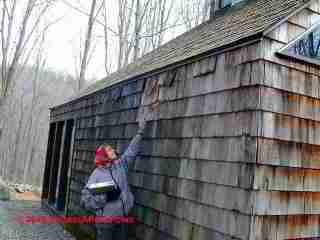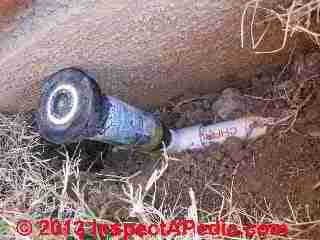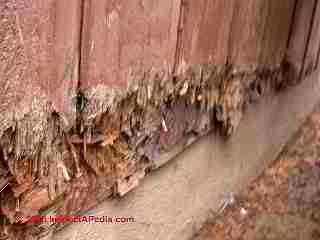 Rain Splash-up or Lawn Sprinkler Damage to Building Exterior Walls
Rain Splash-up or Lawn Sprinkler Damage to Building Exterior Walls
- POST a QUESTION or COMMENT about the damage caused by rain splash-back on building walls & other building components
Water damage to building walls from rain splash or other water sources:
This article explains the causes & effects of rain splashback or roof spillage splash-up on wood siding, causing rot or insect damage.
This article series discusses best practices construction details for building exteriors, including water and air barriers, building flashing products & installation, wood siding material choices & installation, vinyl siding, stucco exteriors, building trim, exterior caulks and sealants, exterior building adhesives, and choices and application of exterior finishes on buildings: paints, stains.
InspectAPedia tolerates no conflicts of interest. We have no relationship with advertisers, products, or services discussed at this website.
- Daniel Friedman, Publisher/Editor/Author - See WHO ARE WE?
Roof Spillage & Rain Splash-Up Damage to Exterior Wall Siding
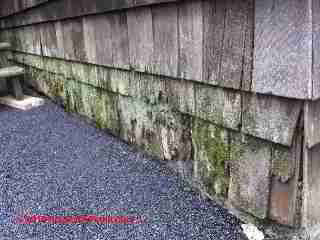 Splashback or splash-up water damage refers to the effects of water on building surfaces when rainwater strikes the ground close to the building.
Splashback or splash-up water damage refers to the effects of water on building surfaces when rainwater strikes the ground close to the building.
Splashback is most severe in areas where water falling off of a building roof strikes the ground because of the concentration of spillage in such areas. These same conditions are a prime source of building or crawl space water entry troubles.
Also see WATER ENTRY in BUILDINGS.
All building siding products, but especially wood-based products, are vulnerable to discoloration, wear, and deterioration or even wood destroying insect invasion when they are installed close to ground level.
Splashback damage is increased when:
- There are no roof gutters installed to intercept and redirect roof runoff
- The roof overhang amount is small - that is the roof edge does not extend far past building walls
- Wood wall siding is installed close to or even in contact with the ground
- Ground slopes towards rather than away from the building
- Paving of drives or patios is brought in contact with wood siding
- No preservative or protective coating is maintained on the wood surfaces
- The building siding is in a shaded or damp area
Photographs below illustrate some of these conditions as well as steps to protect building siding from water damage by roof spillage or splash up.
At below left the combination of modest roof overhang, a natural water trap formed by nearby building walls and retaining wall, and shade were factors in the worn, leaky wood shingle siding on this garage. New asphalt paving was added and sloped to improve drainage out of the area.

Shown below, the absence of sufficient roof overhang combined with a lot of rain splash-up when water strikes the paved surface has led to building siding damage.
But the generous roof overhang shown in our next photo, below, has worked well to prevent siding damage as well as to keep water well away from the building at a rocky site that could otherwise lead to trouble.
The vertical wood siding below was severely damaged from roof spillage and splash-up.
The construction of a combination of a concrete entry platform poured against building siding, poor drainage, and spillage from a roof valley make the home at below right an inviting place for carpenter ants and termites.
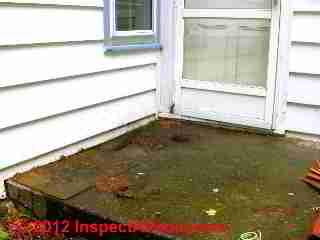
Other Sources of Water Splash-Damage to Building Exterior Walls: lawn sprinkler & lawn irrigation systems
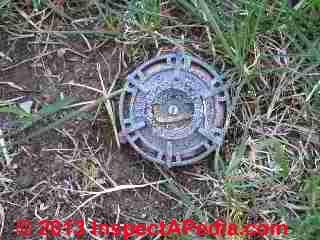
Exterior walls are also vulnerable to damage from recurrent wetting from lawn sprinkler systems and some irrigation systems, and rarely, from the spray of aboveground disposal of septic effluent (not normally discharged close to a building).
Even if originally it was properly set, a mis-adjusted lawn sprinkling system or irrigation system spray head, perhaps struck by a mower or other event, may become turned so as to soak the building;
Our underground lawn sprinkler photo at above left illustrates the sprinkler head of a typical buried lawn sprinkling or lawn irrigation system. This lawn sprinkler is located at a home in Tucson, AZ and was well away from the building wall.
Lawn sprinkler heads located close to the building wall (photo at above right) must be adjusted to spray only away from the building.
We have also found wall damage such as algae growth, rot, and fungal infection of wood-clad walls and some stucco-covered walls due to splashing from simpler lawn sprinklers placed more distant from the building but whose spray or cyclic spray soaks the building wall.
Watch out: beyond cosmetic damage, recurrent soaking of a building exterior wall, especially wood or stucco-over-wood walls, there is risk of rot, insect attack, and mold growth inside the wall cavity.
Splashback Damage Protection for buildings
 Our photo shows thick green algae along the bottom of this brick home in Kingston New York. Notice that there are no gutters on the building eaves - an easy explanation for this splash-up soak-job on the home's walls. I would look for a wet basement as well as mortar loss and frost damage at this home.
Our photo shows thick green algae along the bottom of this brick home in Kingston New York. Notice that there are no gutters on the building eaves - an easy explanation for this splash-up soak-job on the home's walls. I would look for a wet basement as well as mortar loss and frost damage at this home.
As discussed in Best Practices Guide to Residential Construction (Steve Bliss, J Wiley & Sons) and as we also noted
In wall areas subjected to splashback, snow buildup, or high moisture from other sources, rubberized asphalt membranes in widths up to 36 inches can be used to protect the wall sheathing and structure.
Water damage from splashback is common in wall sections located under the eaves of a roof with no gutters. Walls above decks or flat roofs are also prone to moisture damage from splashback or snow buildup.
In all cases, make sure to detail the flashing membrane so that it tucks under the sheathing wrap above and over the step flashing or cap flashing below. If installed along the foundation, the membrane should cover the joint where the sill meets the foundation.
Adapted/paraphrased with permission from Best Practices Guide to Residential Construction (Steve Bliss, J Wiley & Sons) . Steven Bliss.
...
Reader Comments, Questions & Answers About The Article Above
Below you will find questions and answers previously posted on this page at its page bottom reader comment box.
Reader Q&A - also see RECOMMENDED ARTICLES & FAQs
Question: neighbor's watering system is wetting our building
Can you help me find an article to confirm what we have been telling our neighbor? We have repaired our side of cinder block based stucco wall by restucco and painting twice. It is deteriorating on our side due to water. We live in las vegas,NV. Their property is higher than ours. Their bushes and plants are being watered by an irrigation system.
We have tried telling them that water always chooses the lower route. We've had a gardener tell us that no shrubs should be planted within three feet of wall to prevent this problem. Their raised beds further down the wall is causing the same problem.
Since there property is higher, there is no damage to their side of the wall. They say it is our sprinkler system over three feet away from our side of the wall that is causing the problem. Can you direct me to any articles that can help explain this problem to them? - Anon. Sept 2013
Reply:
I'd like to help but need a more clear and confident idea what's going on. Perhaps some photos would help;
Typically a stucco wall is likely to be damaged if it is actually being sprayed by water - say by a sprinkler system or from roof spillage; If you want to argue that your wall is damaged by wet soils around the wall, and if you do not have your own sprinkler system outside that wall, it should be possible to photo document and measure-document the soil wetness when the neighbor's watering system has been running for some time.
: how to protect siding along a deck from snow damage
(Aug 4, 2014) Denise said:
Can I build some protection on my deck to keep snow build up away from the siding?
Reply:
Denise, you can use the email found at our CONTACT link to send me some photos of the deck surface and siding - that may permit a more useful comment.
Normally we protect the wall by flashing and counterflashing, or by flashing beneath the siding that comes to daylight above the deck ledger.
Search InspectApedia for "Deck Flashing" to see details.
...
Continue reading at HOUSEWRAP / SHEATHING WRAP or select a topic from the closely-related articles below, or see the complete ARTICLE INDEX.
Or see these
Recommended Articles
- ALGAE, FUNGUS, LICHENS, MOSS
- EIFS & STUCCO EXTERIORS
- FLASHING SIDING DETAILS
- FLASHING WALL DETAILS
- HOUSEWRAP / SHEATHING WRAP
- HOUSEWRAP INSTALLATION
- PAINT FALURE, DIAGNOSIS
- SIDING DAMAGE by SPLASHBACK
- SIDING EIFS & STUCCO
- SIDING WOOD, FAILURES OVER FOAM BOARD
- SIDING WOOD, FLASHING DETAILS
- STUCCO WAll FAILURES DUE TO WEATHER
- TREES & SHRUBS, TRIM OFF BUILDING
- WATER BARRIERS, EXTERIOR BUILDING
- WATER ENTRY/DAMAGE PREVENTION WITHOUT GUTTERS
- WOOD SIDING FLASHING DETAILS
Suggested citation for this web page
SIDING DAMAGE by SPLASHBACK at InspectApedia.com - online encyclopedia of building & environmental inspection, testing, diagnosis, repair, & problem prevention advice.
Or see this
INDEX to RELATED ARTICLES: ARTICLE INDEX to BUILDING SIDING
Or use the SEARCH BOX found below to Ask a Question or Search InspectApedia
Ask a Question or Search InspectApedia
Try the search box just below, or if you prefer, post a question or comment in the Comments box below and we will respond promptly.
Search the InspectApedia website
Note: appearance of your Comment below may be delayed: if your comment contains an image, photograph, web link, or text that looks to the software as if it might be a web link, your posting will appear after it has been approved by a moderator. Apologies for the delay.
Only one image can be added per comment but you can post as many comments, and therefore images, as you like.
You will not receive a notification when a response to your question has been posted.
Please bookmark this page to make it easy for you to check back for our response.
IF above you see "Comment Form is loading comments..." then COMMENT BOX - countable.ca / bawkbox.com IS NOT WORKING.
In any case you are welcome to send an email directly to us at InspectApedia.com at editor@inspectApedia.com
We'll reply to you directly. Please help us help you by noting, in your email, the URL of the InspectApedia page where you wanted to comment.
Citations & References
In addition to any citations in the article above, a full list is available on request.
- Best Practices Guide to Residential Construction, by Steven Bliss. John Wiley & Sons, 2006. ISBN-10: 0471648361, ISBN-13: 978-0471648369, Hardcover: 320 pages, available from Amazon.com and also Wiley.com. See our book review of this publication.
- Our recommended books about building & mechanical systems design, inspection, problem diagnosis, and repair, and about indoor environment and IAQ testing, diagnosis, and cleanup are at the InspectAPedia Bookstore. Also see our Book Reviews - InspectAPedia.
- In addition to citations & references found in this article, see the research citations given at the end of the related articles found at our suggested
CONTINUE READING or RECOMMENDED ARTICLES.
- Carson, Dunlop & Associates Ltd., 120 Carlton Street Suite 407, Toronto ON M5A 4K2. Tel: (416) 964-9415 1-800-268-7070 Email: info@carsondunlop.com. Alan Carson is a past president of ASHI, the American Society of Home Inspectors.
Thanks to Alan Carson and Bob Dunlop, for permission for InspectAPedia to use text excerpts from The HOME REFERENCE BOOK - the Encyclopedia of Homes and to use illustrations from The ILLUSTRATED HOME .
Carson Dunlop Associates provides extensive home inspection education and report writing material. In gratitude we provide links to tsome Carson Dunlop Associates products and services.



